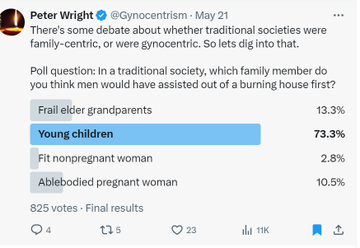
There’s some confusion around the word gynocentrism and it’s meaning, so this piece will explore a little discussed part of the term: -centrism. This suffix makes a restrictive demand, i.e., that women are most important interest we might hold.
The Cambridge dictionary describes centrism the following way:
CENTRISM: The fact of having a particular type of person, place, or thing as your most important interest; the quality of being seen from the point of view of a particular type of person, place, or thing:
- The Academy has been accused of Eurocentrism and gender bias.
- The artist’s newest ventures embody his commitment to ecocentrism
Gynocentrism implies that our focus on the needs and wants of woman is the most important consideration; whether such focus be contained to a brief moment in time, or as applied to the entire duration of human relationships.
For example, when we celebrate Mother’s Day we can legitimately name this brief, isolated act as gyno-centric. Or for a more dramatic illustration of a brief gynocentric event, consider the scenario of a man taking on a knife-wielding maniac who is threatening to hurt his pregnant wife, while the wife retreats and does not help the husband during the fight; in this case the actions of both husband (protecting his wife) and wife (protecting herself) are rightly defined as gyno-centric.1
Alternatively if we consider the overall relationship between the same husband and wife we might ask a new question – is the entire relationship a gyno-centric one? If that husband and wife take turns supporting each other across the duration of their relationship, then the relationship might be rightly referred to as “couple centered” — because by definition a gyno-centric relationship centers exclusively around the woman and her needs and wants. As soon as you have genuine reciprocity in a relationship, one that involves a couple-centric dynamic based on commensurate importance, the relationship can no longer be considered gynocentric.
Employing the word gynocentrism to discuss reciprocal exchanges between men and women, where women are occasional beneficiaries in certain ways, and men are beneficiaries in certain ways, is an erroneous use of the term because such exchanges, strictly speaking, do not constitute a gender centrism across the duration of the relationship – ie. its not a gyno-centric relationship.
While there can be gynocentric elements in relationships, they are historically balanced out by other elements like family-centrism, andro-centrism, child-centrism, pairbonding-centrism, or tribe-centrism. The theory that human relationships are evolutionarily gyno-centric is an exaggeration and a piece of sappy modern propaganda that even some men’s advocates fall prey to.
NOTE:
[1] After writing this essay in 2019, I’ve since become aware of Hanna Wallen’s thesis of the ‘Natural Gynocentrism Fallacy‘ which posits that even isolated, brief acts that I have described above as “gynocentric” are more accurately described as gene-centric, or family-centric behaviours. I agree with Hanna’s proposition.
Women, like ALL family members throughout evolutionary history, needed protection in order to be part of a strong, viable family team. But that isn’t called gynocentrism; it’s called storge (the Greek word for ‘family love’). All family members were protected – as indicated in my recent poll below.
Men, too, were protected if they were injured, old, sick etc. Protection & provision was always based on the shifting needs of various family members…. whoever had the most immediate need, was catered to and cared for.
